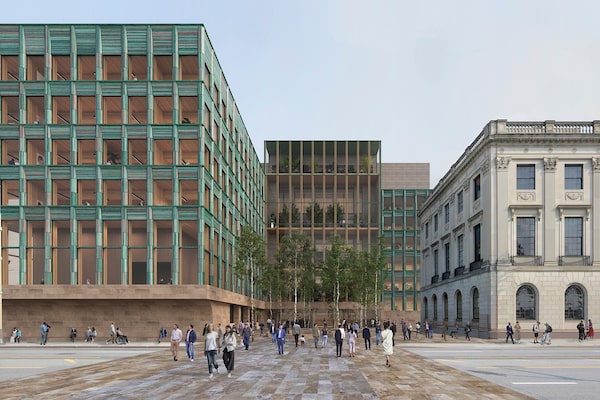
Toronto’s Zeidler Architects and London's David Chipperfield Architects won the design competition for Ottawa’s Block 2.Zeidler Architecture Inc./David Chipperfield Architects
Architecture won a rare victory in Ottawa this week. On Monday, Public Services and Procurement Minister Filomena Tassi announced the results of an international design competition for so-called “Block 2,” a complex of two office buildings on Wellington Street that will serve Parliament.
The winning design, led by David Chipperfield Architects (DCA) of London and Toronto’s Zeidler Architects, will have to work hard. With a structure of mass timber, it will provide committee rooms, support space and 150 offices for parliamentarians. But the project also promises to deliver the most interesting and thoughtful public architecture Canada has seen in a generation.
The key idea in the architecture is diversity. The winning design retains most of the buildings that exist on the site now, between Wellington and Sparks streets. The new elements sit alongside them. “They don’t present as a unified façade,” said Richard Marks of DCA. “We thought that a building that represents Canada should represent diversity. This mix of buildings of different ages and styles and heights is a metaphor for Canada as it is today.”
The two office buildings leave the middle of the site untouched. In that space sit two buildings, including the former American embassy; these will become an Indigenous peoples centre. The Block 2 architects have left generous public plazas around this future centre, giving it pride of place. They push some committee-room space halfway underground, reducing the bulk of the new buildings. The result, at street level, should be an animated conversation between old and new.
For such a task, DCA is a brilliant choice. While Chipperfield himself is English, his firm has an office in Berlin and works extensively in continental Europe, where heritage and new architecture happily co-exist. Their most famous project is the renewal of the Neues Museum, on Berlin’s Museum Island. Their design reconstructed the museum after it had lain in ruins for 60 years, leaving visible scars of its wartime destruction while adding elements in sculptural concrete. New and old speak to each other.

0
150
METRES
Ottawa
River
Centre Block
East Block
Parliament
of Canada
Location of Block 2
West Block
Ottawa
THE GLOBE AND MAIL, SOURCE: TILEZEN; OPENSTREET-
MAP CONTRIBUTORS

0
150
METRES
Ottawa
River
Centre Block
East Block
Parliament
of Canada
Location of Block 2
West Block
Ottawa
THE GLOBE AND MAIL, SOURCE: TILEZEN; OPENSTREET-
MAP CONTRIBUTORS

0
150
METRES
Ottawa
River
Centre Block
East Block
Parliament
of Canada
Location of Block 2
West Block
Ottawa
THE GLOBE AND MAIL, SOURCE: TILEZEN; OPENSTREETMAP CONTRIBUTORS
This approach breaks down the false dichotomy between “modern” and “traditional” buildings that prevails in North America. In Ottawa, the recent war over the Chateau Laurier captured this unhelpful distinction. Some locals, including heritage advocates, wanted to protect the alleged integrity of that building, which is a tourist-trap homage to a medieval French château. A new addition to the hotel, they said, should look identical to what is there already.
Oddly, the DCA/Zeidler scheme will probably please those same folks. The new office buildings have (horrors!) flat roofs and grid-like façades. But these are not so different in scale and proportion from those on the century-old neoclassical buildings nearby. Modernism and neoclassicism have a close familial relationship. The grids, meanwhile, are clad in aged panels of recycled copper – a material familiar from the roofs of the Parliament Buildings, but used in a completely different way.
And on the back of the site, facing Sparks Street, DCA retains all but one of the existing buildings, adding new storeys to several of them – including in one case with brick that mimics the pattern of the original building’s stonework. This approach, guided by Julia Gersovitz of EVOQ Architecture, avoids unnecessary demolition and construction. Visually it distinguishes between old and new, but with a relatively subtle contrast. “We haven’t treated these as museum pieces,” Mr. Marks said. “They are part of a living city.”
The fact that the competition arrived at this result is an excellent sign for public architecture in Canada. A large, multidisciplinary jury sifted through six short-listed entries, arriving at three fine proposals: one led by Renzo Piano Building Workshop, one led by Behnisch Architekten and then the winner. They are quite different. The RPBW scheme imposed a uniform gridded façade along the whole block of Wellington Street, making a gesture of uniformity and liberal rationality. That is another perfectly valid approach.
The winning design, however, provides a nuance and sophistication that is welcome and too rare. It is part of the Long-Term Vision and Plan for Parliament, a massive revamping of the complex. So far that plan has produced some architecture that is conservative, uninteresting and not especially well-detailed.
With luck, Block 2 will survive the transition from an idea to a detailed design, and then into construction – a prospect that could take four years, at an estimated cost of $430-million.
And, with luck, the federal Conservatives will not attempt to make the project into a political football. The incremental cost of the design competition and DCA’s fees, while they have not been made public, are surely no bigger than a rounding error.
The big question: Will the government learn from this experience, and change the way it hires architects and landscape architects? Design competitions such as this are great for major projects. For smaller ones, it’s equally important to hire the right designers, pay them properly, and push for innovation and insight. A national coalition called Rise for Architecture is pursuing this agenda now.
Block 2 shows how architecture can capture government at its most ambitious – and the country at its most sophisticated. There’s enough darkness in our politics these days; we need all the beacons we can find.
Find out what’s new on Canadian stages from Globe theatre critic J. Kelly Nestruck in the weekly Nestruck on Theatre newsletter. Sign up today.